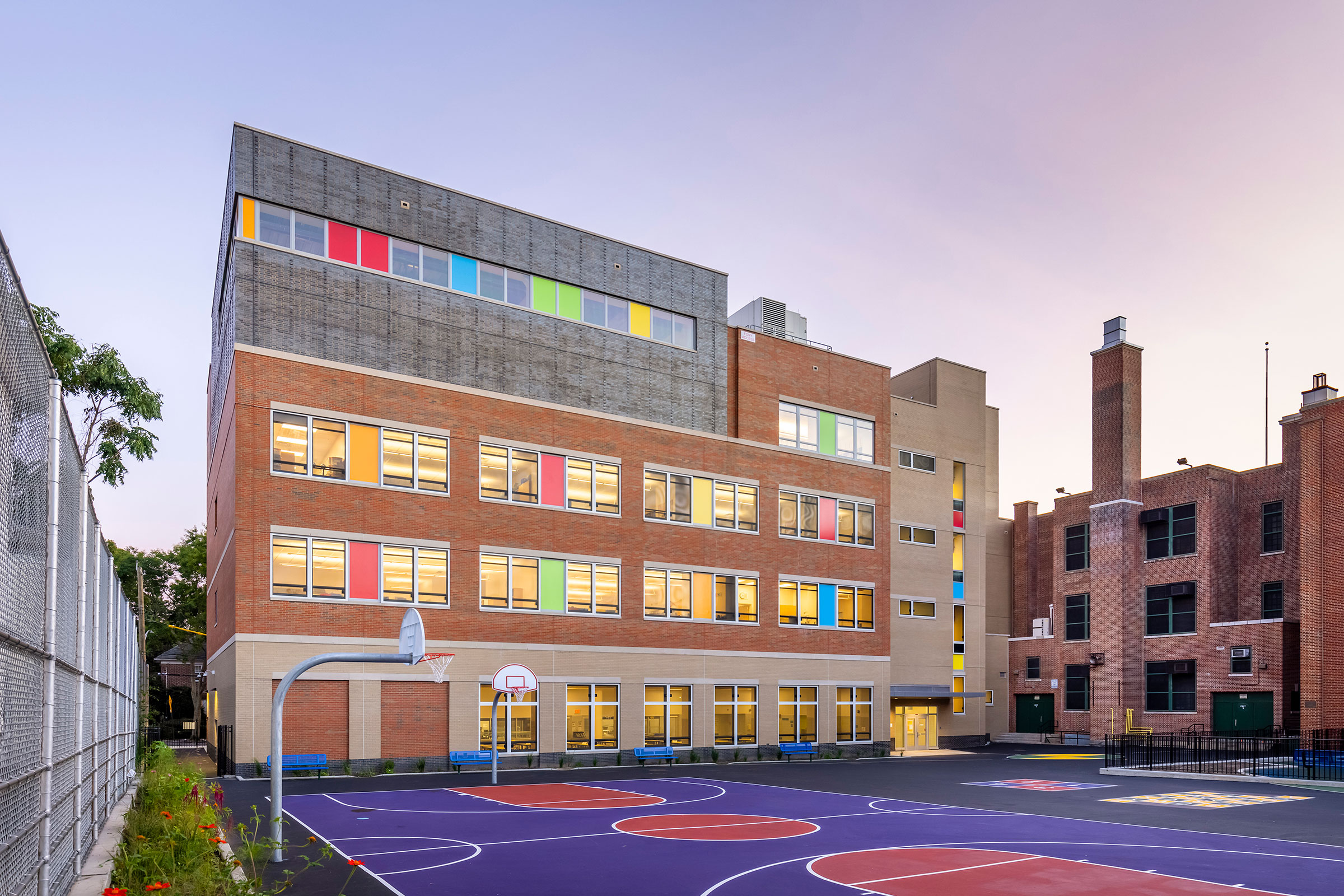Story at a glance:
- Architects and designers look at ways to solve issues like overcrowding in NYC’s public school facilities.
- The NYC Green Schools Guide and Rating System made the city one of the first to have a legal requirement for sustainable design.
- RKTB recently completed the P.S. 19X project, expanding and upgrading a 1925 school building to LEED Gold equivalent.
New York City’s public school system is a point of pride—producing excellent academic performance and achievement with the potential to become even better. But the facilities’ age, challenges with expansion, and design flaws typical of an earlier architectural era have not always adequately supported the work of students, teachers, and administrators. That’s something some of our own designers can speak to from personal experience as former New York public school students. Overcrowding has been an issue, for example, exacerbating the strain on dated HVAC infrastructure and resulting in conditions that can be stifling.
The New York City School Construction Authority (SCA) has been on a mission to change that since it was created in 1988. In 2005 SCA went further, acting on the principle that sustainable design creates healthy and engaging spaces and establishing the NYC Green Schools Guide and Rating System (GSG) for the design facilities renovation and modernization projects as well as for new school buildings. Its adoption made New York City one of the first and largest school districts in the nation to have a legal requirement to comply with sustainable design and construction guidelines.
At RKTB Architects, we believe sustainable design is inextricably linked to the health and well-being of a building’s occupants. It is crucial to have good, safe, and healthy buildings for everyone—especially for children. Our prolific K-12 design practice has more than 40 years of experience working with New York City public schools. Since its introduction, we have honed our expertise in the ever-tightening requirements of the Green Schools Guide, which we meet or exceed on every project. At P.S. 19X, a project we recently completed in the Woodlawn neighborhood of the Bronx, for example, we exceeded the minimum standard and achieved an expansion of an existing 1925 school building that is equivalent to LEED Gold while simultaneously renovating and upgrading the existing building.
Before our team began work on P.S. 19—also known as The Judith K. Weiss Woodlawn School—the student population had long outgrown its historic building, with enrollment numbers continuing to rise with each passing year. Working in partnership with SCA (the agency in the dual role of both client and construction manager), our team at RKTB delivered an addition that more than doubles the school’s floor area, adds modern features and amenities, and provides a healthier and more sustainable environment for the students.
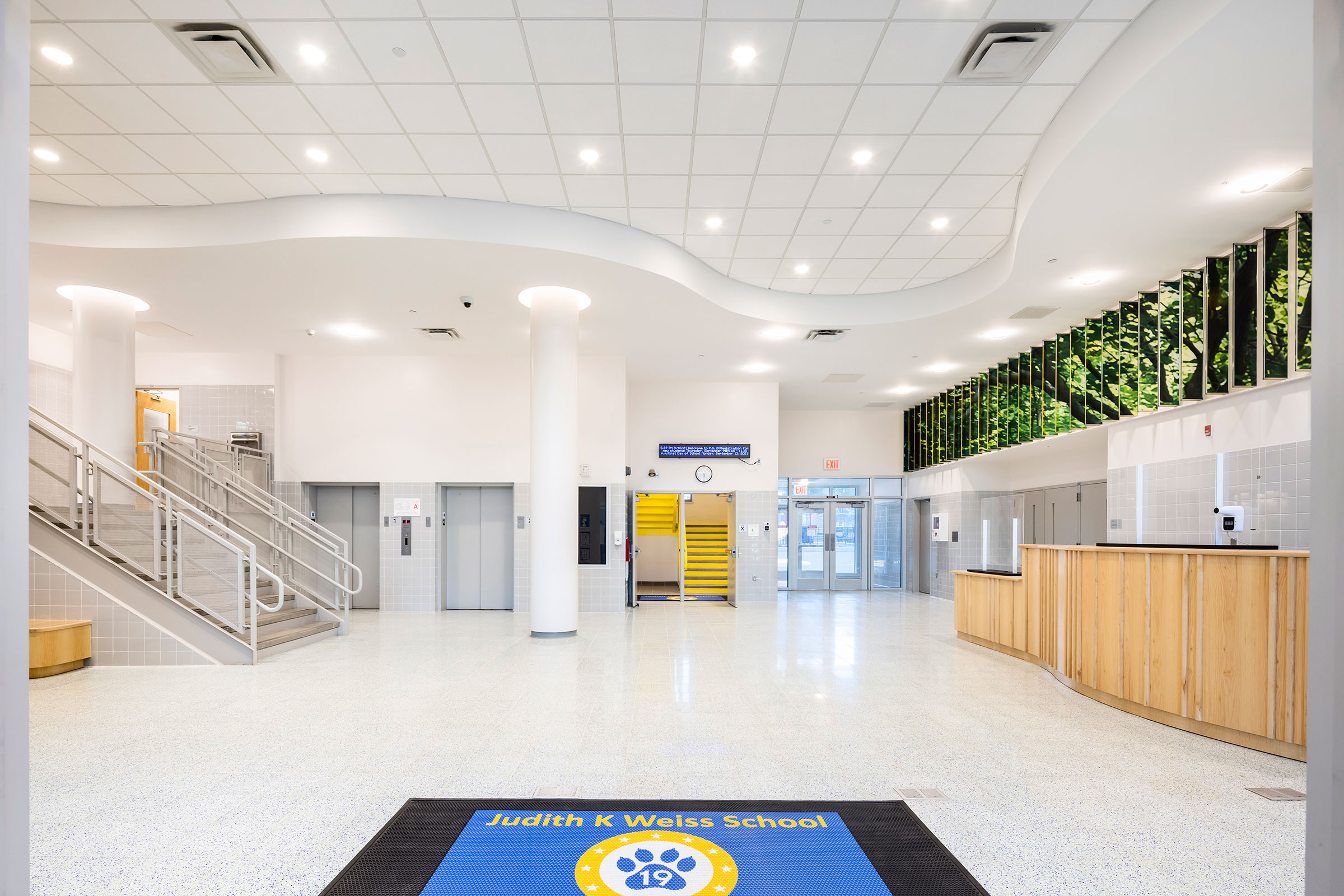
Building renovation at P.S. 19X included replacing outdated administrative and cramped assembly spaces with new, modern classrooms with operable windows and plenty of natural light—all with modern technology and materials, finishes, and systems. Photo by Albert Vecerka
The renovation of the existing building’s interior included replacing outdated administrative and cramped assembly spaces with new, modern classrooms with operable windows and plenty of natural light—all outfitted with modern technology and materials, finishes, and systems. During construction, the students and faculty had to be able to use the existing building without major disruption, which required us to be nimble in addressing unforeseen field conditions and inventive with how to connect building systems and the addition itself. We wanted to be sure our construction process was as sustainable as the final product, so we worked with our contractors to develop a plan to divert as much as 95% of our construction waste from landfill and manage stormwater onsite.
P.S. 19X includes new administrative offices—replacing those in the existing building—as well as a double-height gymnasium, a combined cafeteria and auditorium (cafetorium), and a new entrance with a welcoming, airy lobby. We limited the addition to four stories to match the scale of the Woodlawn neighborhood, which is primarily single-family. Colorful window surrounds on the exterior exude a playful atmosphere and welcome the community to engage with the campus.
The new entry is a critical element of the project because you can’t enjoy the benefits of a sustainably designed environment if you can’t access it. The front door to the existing school building was at the top of a flight of stairs, limiting access for students with mobility issues. A new street-level entry and elevators make all the spaces in the addition accessible to students with disabilities. And while the floor-to-floor heights in the existing building do not meet the standard for SCA’s new construction projects, an exception was made to allow for barrierless connections between the old building and the new, so most spaces in the existing building are now fully accessible to all students as well.
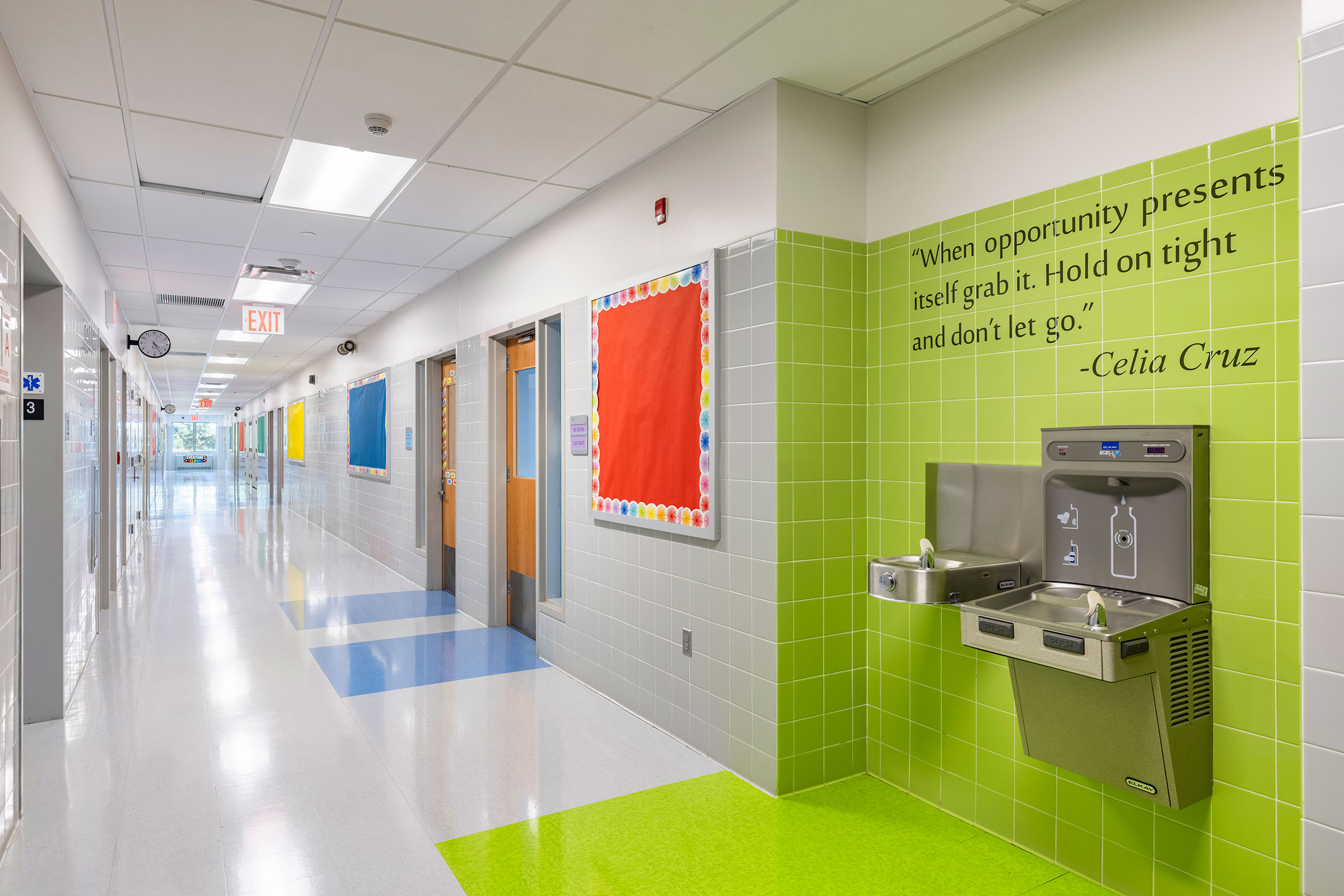
RKTB Architects renovated a 1925 school building to make a vibrant new school in the Bronx. Photo by Albert Vecerka
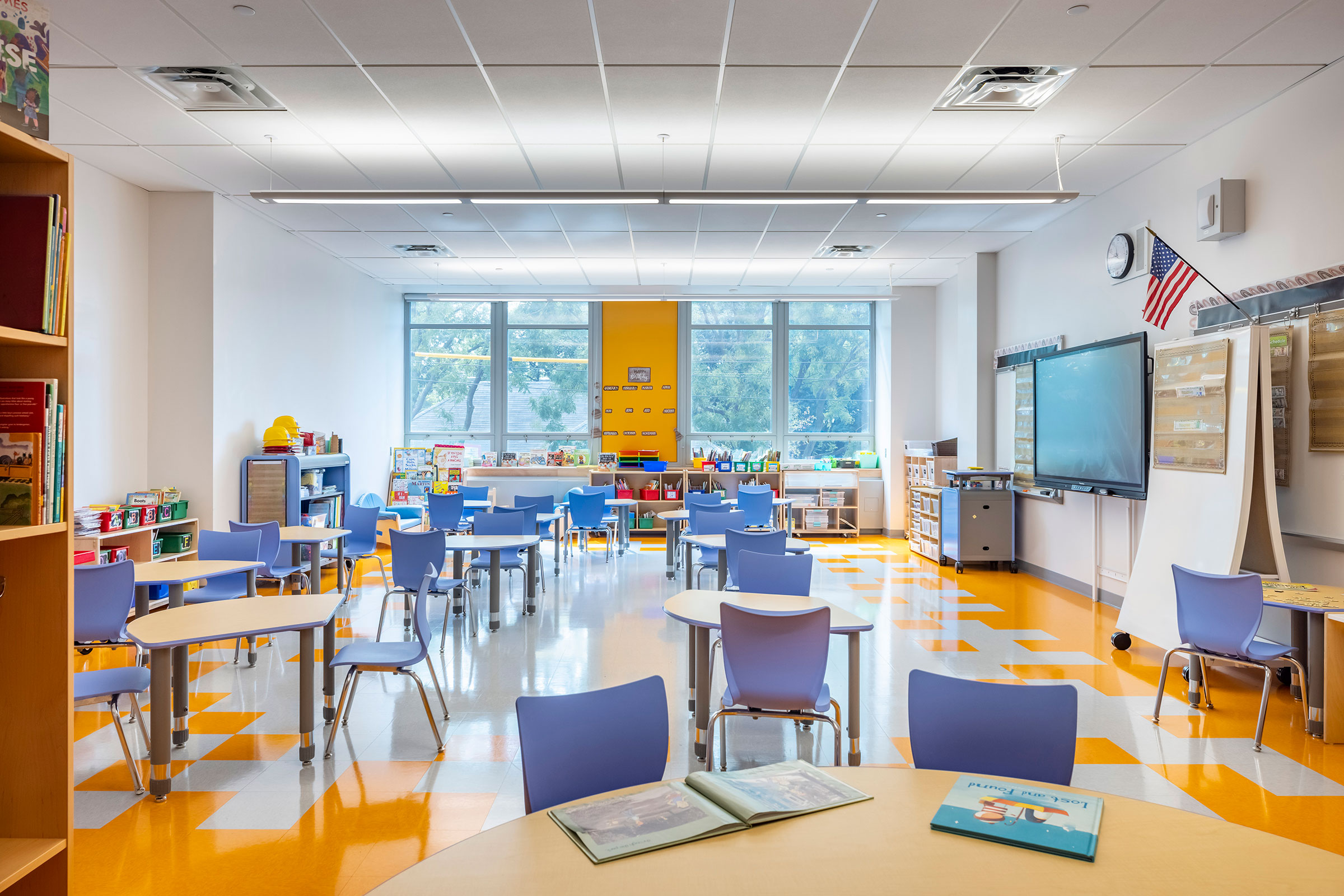
Inside P.S. 19X, The Judith K. Weiss Woodlawn School. Photo by Albert Vecerka
The backbone of sustainable construction is energy efficiency, and we employed systems and materials that help to reduce overall energy costs by more than 30% compared to the Green Schools Guide baseline. To relieve pressure on the HVAC system, we used R-15 insulation in the above-grade wall assemblies and R-10 in those below grade; roof construction included R-30 insulation under a performative cool roof that helps reduce heat gain. A state-of-the-art building management system will track energy usage and building performance, allowing adjustments for adjustments by facility directors; daylight harvesters and occupancy sensors in classrooms and offices will help limit the load from lighting systems. And while there are no renewables onsite, the school will be sourcing at least 35% of its electricity from renewable sources.
Because of increasingly stringent LEED standards and New York Building Codes, this was the first school project for RKTB where performing a blower door test was required. Large fans were placed in the building, and we measured the amount of air exhausted to confirm that the building was airtight. The test resulted in the construction team finding and sealing openings in the building envelope that we would have been otherwise unaware of, resulting in a more energy-efficient structure.
This tight envelope also helps control the school’s indoor air quality, which has always been a critical part of sustainable and healthy design but is even more so after the coronavirus pandemic. P.S. 19X followed all the LEED requirements for indoor air quality, including strict standards for mechanical systems and their filters. They were sealed from exposure to pollutants until they were fully installed, after which the system flushed out the air from the building’s construction. The fact that the structure was built during the height of the pandemic led to the upgrading of all air-handling equipment and filters to maximize air quality and remove pathogens.
Low-emitting materials and finishes—from flooring to paint to furniture—were specified as much as possible to minimize any off-gassing that could harm the indoor air quality during the building’s use. We also used locally sourced materials where possible; all the concrete, for example, was sourced from Long Island City, just a borough away—and with recycled content.
Designing sustainably means not overbuilding, and at RKTB we pride ourselves in pursuing strategies that use space efficiently and minimize each structure’s footprint. In the classrooms this meant using modular furniture that can be rearranged to address the changing needs of both students and their teachers over time. In the new entry it meant creating open spaces large enough to double as gathering or assembly space. And in the cafetorium it meant combining the uses of a full-service cafeteria with an auditorium complete with stage, lighting, and sound equipment. A common feature in schools across the country, the P.S. 19X cafetorium is one of very few such venues within the NYC public school system, providing students with a flexible suite of modern amenities without having to double the footprint.
That saved space allowed us to expand the size of the outdoor play spaces and gathering areas, which are landscaped with native Panicum Virgatum—otherwise known as “Northwind.” These plants require minimal maintenance once established, requiring no permanent irrigation and reducing our landscaping water usage to near zero. Inside, low-flow and high-efficiency plumbing fixtures will reduce water usage by more than 30% above the Green Schools Guide baseline.
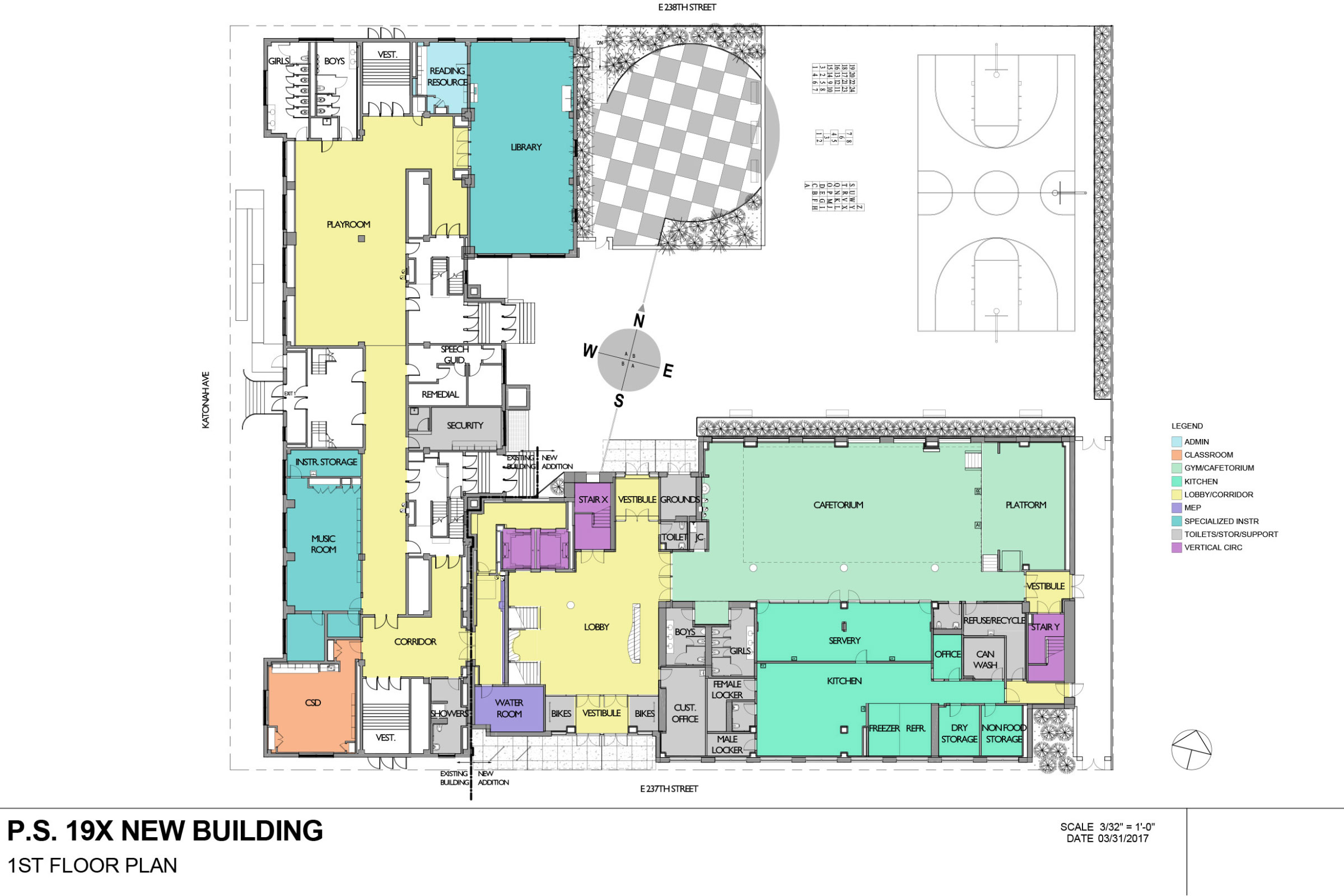
First floor plan. Courtesy of RKTB Architects
All the strategies above help create a healthy, safe, and welcoming environment that supports students’ ability to learn. But a piece that we at RKTB believe is critical to making such a space truly inspiring is to personalize it by connecting it with the community it serves. The existing school building was and remains a community landmark along Katonah Avenue, but its monumental walls and opaque metal doors didn’t invite the community in.
The new, glazed entry and expansive windows invite people to engage with the school their children attend and be curious about the programs within. The new amenity spaces can also be used by the broader community, broadening the reach of who the building serves and activating the campus outside of school hours.
Woodlawn’s history is woven throughout the building, with quotes printed on colorful the great poets, thinkers, musicians, and dreamers who either hail from the area or are buried in the famed Woodlawn Cemetery nearby, including Irving Berlin, Miles Davis, and Celia Cruz, among others.
It’s always rewarding to see the collaboration between our design team, consultants, and clients come to life in a finished project—to see what months and years of discussion and drawing looks like in reality. But it is even more rewarding to see a completed learning environment filled with students, teeming with activity, and knowing that our efforts have enhanced learning and teaching processes. The expansion of the school created capacity for an additional 200 students, transforming the formerly cramped quarters into ample space for the students to learn and explore in a healthy environment that will nurture and inspire them as they grow.
Creating this type of space is only possible by leveraging sustainable design to its fullest to make every building we can better and healthier for its occupants, its community, and the environment at large. For us at RKTB, to imagine that the students of P.S. 19 will look back and remember fondly that their school environment sparked joy and curiosity is inspiring and motivating. Improving their lives through design is what drives our team to make schools better and better, one project at a time.
Alex Barclay, also an associate with RKTB, contributed to this article.

